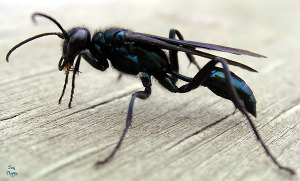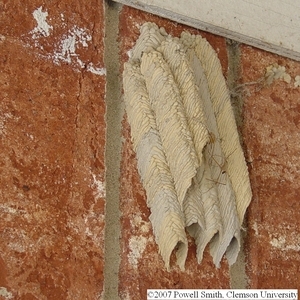Texas A&M AgriLife Extension – Paper Wasps, Yellowjackets, and Solitary Wasps
Identification
Mud daubers are one of the several insects you can see buzzing around your house, but there are some key identification characteristics that can distinguish them from the other wasps you may find. Mud daubers are about ¾ to 1 inch in length and can vary in coloration between species: many are entirely black, but others can be black with yellow markings or even be an iridescent blue-black color. One major identifying feature is that mud daubers have a long, narrow “waist” (also called a petiole) that connects the thorax to the abdomen.
Mud daubers are solitary insects, meaning each nest only has one wasp that is responsible for all the necessary tasks. The nests are constructed from mud by a single mated female and they can vary in shape, from pipe-shaped to globular. These nests can be found under eaves, in garages, or any protected area.
Biology
Once a female mud dauber has mated she will search for a new nest site and start gathering balls of mud to use for nest construction. She will choose a new nest site based on protection from weather, mud availability, and spider availability. Once the first brood cell in the nest has been constructed, she will start hunting for spiders to provision that cell. When a spider has been capture, the female mud dauber will paralyze it before placing it in the cell. One egg is usually placed on the first spider, which is placed in the back of the cell. The female will continue to collect spiders until the cell is full, which can be up to 25 spiders. Once the cell is full it will be capped over and the female will start construction on the next brood cell. When an egg hatches into a larva it will eat all of the spiders in entirety, which then provides room for the larva to pupate into an adult mud dauber.



